Cook Korean Food at Home - A Beginner’s Guide
Have you ever thought of cooking Korean food at home? Oh, I see.... You felt it was kind of a big step. Well, this website is for someone like you. You guessed it right — I’m trying to convince you that it’s not that difficult to make Korean dishes at home. And, some of them can be made without you venturing into a Korean grocery store.
Korean food was once a rarity in English-speaking countries, but today it is well known. To find out just how popular Korean food is, type “Bulgogie” or “Boolgogi” in Microsoft Word. You will notice that a curly red underline shows up, with a recommendation that the correct spelling for the famous Korean barbecue is “Bulgogi”. Why is this spelling more correct than the other two? I don’t know. I would say the real correct spelling is “불고기". Anyway, it appears that some Korean food names are now recognized as part of the English vocabulary.
This website will show how you can cook Bulgogi and many other Korean dishes at home in the way Korean families do — with minor adjustments to accommodate your American lifestyle and ingredient availability.
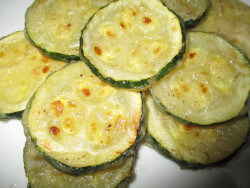 Some of these Korean dishes go very well with ordinary dishes made at American homes. In other words, you can prepare your home meal as you normally would and just add one or two Korean dishes to give variations to your dinner. Many Korean dishes are low in fat and high in fiber, which is good if you are watching calories. On the other hand, some may have a sodium content that’s higher than ideal. But then, it all depends on which dish you are talking about.
Some of these Korean dishes go very well with ordinary dishes made at American homes. In other words, you can prepare your home meal as you normally would and just add one or two Korean dishes to give variations to your dinner. Many Korean dishes are low in fat and high in fiber, which is good if you are watching calories. On the other hand, some may have a sodium content that’s higher than ideal. But then, it all depends on which dish you are talking about.
Most of you have probably been introduced to Korean food at Korean restaurants. Some of the typical Korean restaurant menu items are difficult to make and rarely cooked at home in Korea, while others are quite easy to make. For example, Bulgogi, the Korean BBQ made with beef, is very easy to simulate at home.
Our Recipes Page has 25 recipes for easy-to-cook Korean dishes:
We also have a Korean Restaurant Menu Page, describing typical dishes that you can order in a Korean restaurant. The dishes covered in that page are:
Home-Style Korean Food
Many of the Korean restaurant menu items are not exactly everyday family meal in Korea. What are typical home dishes, then? An everyday Korean home meal consists of a number of side dishes ("Banchan" in Korean), served along with steamed rice and, optionally, a bowl of soup.
In your own home, however, you don’t need to be a Korean traditionalist, which means you can just enjoy Korean side dishes and skip the steamed rice. But if you want to include steamed rice, that’s wonderful – it’s going to be an authentic Korean meal. For those of you so inclined, we have made a separate page, How to Cook Steamed Rice.
Korean Side Dishes (반찬 : Banchan)
There are countless number of side dishes in Korea, but they can be roughly grouped into several categories.
Grilled meat or fish (구이 : Gu-ee)
In our Recipes Page, we have Bulgogi, or Korean BBQ, as a representative example of this category. Grilling (or barbecuing) is an important method of cooking in Korean cuisine, and grilled fish in particular is an everyday item.
In traditional Korean architecture (the prevalent form until the early 20th century), the kitchen is not an indoor space, but a semi-indoor space. Although the kitchen is structurally connected to the living quarters, it does not share air circulation with any of the rooms. To go from a room to the kitchen, one has to wear shoes and walk at least a few steps across a yard. In that arrangement, it was easy to enjoy barbecued meat and fish without having to worry about the smoke and smell entering into the living quarters.
Pan-fried meat / fish / vegetables (전 : Jeon )
These are roughly cookie-sized, pan-fried patties made with various ingredients. 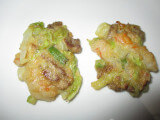 Jeon can be made with beef, fish, shrimps, vegetables, Kimchi or some combination thereof. Jeon is made almost every day as Banchan in Korea. And, if there is a big family gathering, Jeon is prepared in a large scale in advance. In our Recipes Page, we have Beef-Shrimp Jeon (고기 새우 전), Fish Jeon (생선 전), Zucchini Jeon (호박 전) and Kimchi Jeon (김치 전).
Jeon can be made with beef, fish, shrimps, vegetables, Kimchi or some combination thereof. Jeon is made almost every day as Banchan in Korea. And, if there is a big family gathering, Jeon is prepared in a large scale in advance. In our Recipes Page, we have Beef-Shrimp Jeon (고기 새우 전), Fish Jeon (생선 전), Zucchini Jeon (호박 전) and Kimchi Jeon (김치 전).
Cooked and seasoned vegetables (나물 : Namul)
The wild nature of the Korean landscape offers many delicious edible plants such as "Doraji" (도라지: Platycodon grandiflorus), "Ssook" (쑥: Artemisia princeps orientalis), "Naeng-ee"(냉이: Capsella bursa-pastoris), etc., which grow all over the fields and mountains in Korea. These plants are called “Namul” (나물). 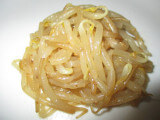 The same word “Namul” also refers to the cooked and seasoned dish made with such plants. For centuries and centuries, Namul picking excursions over just a short distance were the usual way for Koreans to get Namul. Nowadays, Koreans pick up Namul at supermarkets and pay with touchless cell phone apps. But their love for Namul remains unchanged.
The same word “Namul” also refers to the cooked and seasoned dish made with such plants. For centuries and centuries, Namul picking excursions over just a short distance were the usual way for Koreans to get Namul. Nowadays, Koreans pick up Namul at supermarkets and pay with touchless cell phone apps. But their love for Namul remains unchanged.
Supermarkets in Korea sell the three types of plants just mentioned (which you’ve probably never seen or heard of). But by far the most readily available Namul at groceries are soybean sprouts and mung bean sprouts. And, spinach is another material for Korean Namul. In our Recipes Page, we have Soybean Sprout Namul, Mung Bean Sprout Namul and Spinach Namul.
Side dishes prepared by braising ingredients in soy sauce (조림 : Jorim)
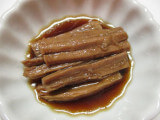 The primary meaning of the word “Jorim” is “reducing a sauce”, but the same word also refers to a side dish made with that method. Fish, beef, or vegetables are cooked in soy sauce-based liquid until the liquid is much reduced to make a "Jorim". In our Recipes Page, we have Beef Jorim (장조림) and Potato Jorim (감자 조림).
The primary meaning of the word “Jorim” is “reducing a sauce”, but the same word also refers to a side dish made with that method. Fish, beef, or vegetables are cooked in soy sauce-based liquid until the liquid is much reduced to make a "Jorim". In our Recipes Page, we have Beef Jorim (장조림) and Potato Jorim (감자 조림).
Stews with meat or fish often made with tofu, zucchini, etc. (찌개 : Jjigae)
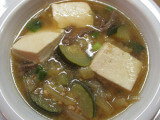 Jjigae is a stew placed near the center of the table for sharing. Compared to a soup (Guk), which is served individually to each person, a Jjigae is more concentrated. Because a Jjigae is saltier than a soup, it can be thought of as a “liquid side dish”. In our Recipes Page, we have Doenjang Jjigae (된장 찌개).
Jjigae is a stew placed near the center of the table for sharing. Compared to a soup (Guk), which is served individually to each person, a Jjigae is more concentrated. Because a Jjigae is saltier than a soup, it can be thought of as a “liquid side dish”. In our Recipes Page, we have Doenjang Jjigae (된장 찌개).
Kimchi
(김치 ) The pronunciation is closer to "Gimchi" than "Kimchi".
At this point, you may be holding a burning question: “What about Kimchi?” Kimchi is a fermented food, like cheese or wine. Once you have acquired a certain amount of skill and knowledge, you can make Kimchi on your own. But for now, buying commercially available Kimchi would probably be the most practical option. In our Korean Grocery Page, there is a special Kimchi section explaining how you can best enjoy commercially available Kimchi (yes, there is a trick to it).
Korean Soups (국 : Guk)
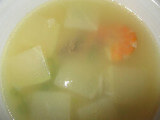 There are dozens of different soups in Korean cuisine, made with vegetables, beef, fish, clams, seaweeds, egg, etc. A Korean soup is placed next to the bowl of steamed rice and stays on the table until the end of the meal. In our Recipes Page, we have Miyeok Soup (미역국), Radish Soup (무국) and Spinach & Soybean Paste Soup (시금치 된장국).
There are dozens of different soups in Korean cuisine, made with vegetables, beef, fish, clams, seaweeds, egg, etc. A Korean soup is placed next to the bowl of steamed rice and stays on the table until the end of the meal. In our Recipes Page, we have Miyeok Soup (미역국), Radish Soup (무국) and Spinach & Soybean Paste Soup (시금치 된장국).
Do I need special ingredients sold only at Korean /Asian groceries?
Soy Sauce ( 간장 : Ganjang) is a Must-Have
For your Korean cooking adventure, one thing absolutely needed is soy sauce (a black liquid sauce made from soy beans). As long as you have a small bottle of soy sauce in your kitchen, you can make a number of Korean dishes using ordinary ingredients such as beef, shrimp, zucchini, onion, etc. Luckily, soy sauce is nowadays sold by all grocery chains in the United States. More info about soy sauce is available in our Korean Grocery Page.
Gochujang (고추장 : red pepper paste) & Gochugaru (고춧가루 : red pepper flakes)
If your town has a Korean grocery store, you can buy Gochujang (red pepper paste) and Gochugaru (red pepper flakes). With these, you can make many delicious Korean dishes that are hot and spicy. For further details, see our Korean Grocery Page.
Special Ingredients Specific to Some Dishes
These are explained in each recipe in our Recipes Page and more detailed descriptions are given with pictures in our Korean Grocery Page.